Camp Pike - History and Construction
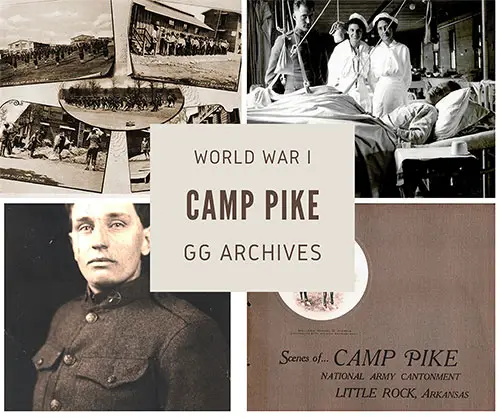
Photo Collage of Camp Pike
Camp Pike, situated eight miles northwest of Little Rock, Ark., houses the National Army forces drawn from Arkansas, Louisiana, Mississippi, and western Alabama. Here an up-to-date military city of 42,000 capacity had virtually to be built in the midst of a wilderness.
Ground was broken for the camp on July 9th. The site was almost entirely covered with second-growth timber, the nearest railroad was five miles away, and supplies had to be brought by truck from Little Rock over hilly highways. A vast deal of rock was encountered in ditching for water and sewer pipes—nearly 75 percent of the total excavations, in fact.
Labor was scarce, as Camp Funston, in Kansas, had an earlier start and had secured most of the available supply. But the contractors ranged far and wide, even into the Mexican States of Chihuahua and San Luis Potosi, with the result that all handicaps were overcome. This camp has little level ground, resembling Camp Ayer and Camp Gordon in that respect, and many heavy grades in the road system result. The 75 hospital buildings cover 47 acres of ground.
Little Rock, which plays the role of host to Camp Pike, is the largest city in Arkansas. It was settled in 1814, becoming the seat of the territorial government in 1820, although at that time it had a population of only 20 people.
Situated on both banks of the Arkansas River, the city takes its name from the rocky promontory which rises to a height of some 5o feet above the river. It was called Little Rock in contradistinction to the bold precipice, some 3 miles above and about 50o feet high, which was known as Big Rock. To the west of the city and of Camp Pike the foothills of the Ozark Mountains rise, but to the east are fertile cotton fields and corn lands. The Arkansas River is navigable to boats of considerable draft as far as Little Rock, while steamboats of shallow draft go as far as Port Smith, 165 miles to the west.
At the outbreak of the Civil War the State was hopelessly.divided in sentiment. The upland people, living west of Little Rock, were Unionists and the cotton-territory folk, living east, were Secessionists. Camp Pike stands near the line of cleavage.
Camp Pike is named in honor of General Zebulon M. Pike, an American soldier and geographer. Born in Lamberton, N. J., in 1779, he spent his boyhood in Pennsylvania, and in 1805 started from St. Louis on an expedition to locate the source of the Mississippi. He was successful. Later he followed the Missouri and Osage rivers into Kansas, then went southward to the Arkansas, proceeding through Kansas and Colorado to the present site of Pueblo, and viewed Pikes Peak (since named in his honor).
While searching for the Red River he lost his way and wandered into Mexican territory across the upper Rio Grande. He was arrested, taken to Chihuahua, and, after some delay, escorted back to the border. In the War of 1812 he led American forces into Canada and was killed at York by falling rock when the retreating force blew up a powder magazine. He died while his nomination for brigadier general was pending.
Construction of Camp Pike 1917
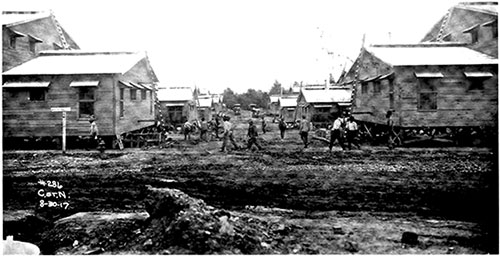
Scene During the Construction of Camp Pike. Photo dated 30 August 1917. Architecture and Building (October 1917) p. 95. | GGA Image ID # 11394edffb
"Too marvelous for comprehension," said Major General Samuel E. Sturgis, after his first inspection of the Camp Pike. There the contractors broke ground on July 9th, 1917.
Then the reservation near Little Rock, Arkansas, was a wilderness of rocks and scrub oak, the nearest railroad was seven miles away, and it was not until July 16th, 1917 that tracks of the Missouri Pacific, blasting their way through the rocks, reached the cantonment. Now its 1,663 buildings furnish accommodations for 43.900 men and 17,800 horses.
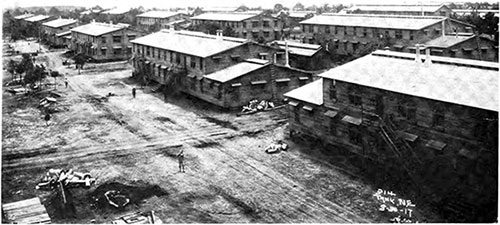
Camp Pike During Construction. Photo dated 30 August 1917. Architecture and Building (October 1917) p. 95. | GGA Image ID # 11394ef07a
The work was carried out despite unusual difficulties in engineering and construction. Contrary to the general rule of selecting level sites for cantonments, Camp Pike is on a series of hills, and full of steep grades.
Almost every foot of land had to be cleared of a comparatively heavy growth of forest. The excavating averaged seventy-five percent, rock, and was of the most challenging kind.
Cuts ran as deep as 27 feet, and in one section the excavating for sewers averaged a depth of 18 feet for over a mile.
There was no natural water supply, not even a spring on the reservation—the nearest artificial supply being eight miles away. There was no railroad, and for weeks all material and all labor had to be hauled from Little Rock, eight miles away.
Government work at Fort Riley and Louisville had started, in June, and had drained the territory of both labor and material, and the supply of the former especially was scarce and inadequate.
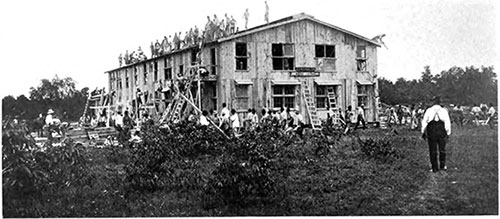
Two-Story Barracks Constructed at Camp Pike in Less Than 3 Hours. Architecture and Building (October 1917) p. 96. | GGA Image ID # 113951100d
The contractors, James Stewart & Co., Inc., of New York, immediately summoned to Camp Pike their experts from that city, from St. Louis, Salt Lake City, Chicago and Toronto, and within a week had a highly organized staff of specialists in every branch of the work on the reservation.
Wells were driven, and water supply was set up that was entirely adequate for the needs of the camp; a temporary electric light and power system was installed at once.
The lumbermen of Little Rock and Arkansas rallied loyally to the support of the contractors, and within a brief time, lumber was flowing in at the rate of a million feet a day, later at the rate of a million and a half feet daily.
The country was combed for labor until the force of workmen approached 10.000 men and the payroll $375,000 weekly.
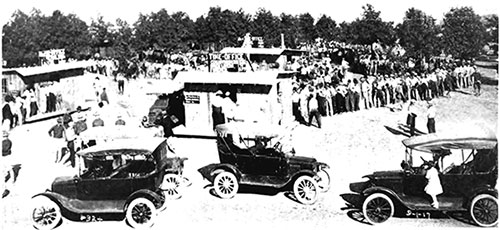
Pay Day for some 10,000 Workers of the Construction Crews at Camp Pike. Architecture and Building (October 1917) p. 96. | GGA Image ID # 11395e64d7
Nothing was overlooked that would save or gain time. The work of unloading the nearly one hundred cars that presently arrived daily went on without intermission; night shifts worked under powerful searchlights.
Whenever possible, machinery or fittings needed at once, sometimes weighing several thousand pounds, were shipped by express, and passenger trains were held that quick connections might be made.
From the very start, work that could be done after dark was taken up by night shifts when the day gangs quit. Trench digging, drilling, and blasting went on under searchlights, and pipe laying was done under traveling lines of incandescent which were moved ahead as the work progressed.
The night was found to be an especially favorable time for the operations of the powder men, as they did not then interfere with the work of others, and as the depth of the cuts practically reduced much of the tunneling to mining operations, this could be done at night as effectively as in the daytime.
The air compressors and the sewer digging machines worked twenty-four hours a day. Work on the concrete septic tank went on night and day, and pouring of concrete never stopped after it once began.
No saving of time was too small to be looked after. Delivery of material and the output of the mills were closely watched all the time, and at the least sign of delay, or scarcity in the special kind of lumber needed for a particular building or unit, this material was expedited.
Buildings were roofed out of the usual order of construction, that the men might continue work on the interior and under shelter if rain came up. By laying the joist, putting on the floors, then laying down the studding, covering these with the outside sheathing and shiplap, and then raising and fastening the sides in place, speed was made.
Some idea of what this meant in quick construction may be gained from the fact that on August 16th, a 43 x 140-foot two-story barracks was erected, sheathed, roofed, floors laid, doors hung, stairs up, windows in and even screened, and scaffolding removed, in two hours and 55 minutes.
Water is supplied from the waterworks at Little Rock through a 16" main, 8 miles in length, at which point there is a booster station, consisting of three 3-stage centrifugal pumps operated by 100-H.P. motors.
These pump the water, to the elevation of the cantonment site, a total lift of 400 feet, into five storage tanks having a full capacity of one million gallons. From this point, the water is distributed by four motor-driven pumps throughout the reservation, in 30 miles of redwood and cast-iron mains.
The sewer system consists of a septic tank, three main trunks, with a length of about six miles, and nearly twenty-one miles of laterals. The septic tank is of concrete 50 by 100 feet in size and ten feet deep and divided into eight compartments having a capacity of 350,000 gallons.
Plumbing is provided in almost 507 of the 1,663 buildings comprising this cantonment, the installation of which required the employment of from 300 to 400 plumbers for weeks.
The electric energy for the permanent electric light and power system of 3 phase at 13,200 volts is furnished from Little Rock through a seven-mile transmission line to the cantonment transformer station.
The installation for the outside wiring required 1,150 poles. 103 transformers and 30 miles of mainline, with 170 miles of primary and secondary lines to provide electric current for 278 street lighting fixtures. The inside wiring required the installation of 200 miles of wire for 30,000 outlets.
Transporting to and from work and feeding and caring for the big army of workmen employed at Camp Pike was one of the related but significant problems the contractors had to solve along with their actual construction.
Every morning half a dozen trains, in addition to other conveyances, brought thousands of men to the cantonment from Little Rock and carried them back at night. Other thousands never leave the reservation.
Meals were provided for all and sleeping quarters for at least half of the laborers. To do this, the barracks, to be occupied later by the soldiers, were fitted by the Company as mess houses, and in these, the employees were fed and housed.
Twenty of these great dining halls, each feeding from 200 to 300 men at a meal, have been opened. This required the serving of an average of 15,000 meals per day, requiring the following supplies:
- Beef 3,500 pounds
- Beans 300 pounds
- Butter 500 pounds
- Cabbage 750
- Ham 600
- Cheese 125
- Bacon 700
- Sugar 1,500
- Potatoes.2,250 pounds
- Eggs 300 dozen
- Onions 225 pounds
- Bread 4,500 loaves
- Coffee 600 gallons
The original cantonment provided for 667 buildings, to which additions have been made from time to time until it now comprises 1,663 buildings, of which 337 are barracks, most of them two stories in height, 103 officers' quarters and 75 base hospital buildings, giving a capacity of 1,000 beds.
The total number of cars, containing material of all sorts, unloaded up to October 21st was 4,331. Among the main items of materials required in the construction were the following:
- 48,000,000 feet of lumber
- 4,400,000 square feet of roofing
- 4.600,000 square feet of floors
- 500,000 square feet of wallboard
- 82,000 door and window openings
- 12,000 kegs of nails
- 10,450 plumbing fixtures
The base hospital, regimental medical buildings and officers' quarters were heated by steam, an innovation in cantonment building in the southeast, which required boilers having a capacity of 8,200 horsepower, providing steam distributed through 25 miles of steam pipes into 3,890 radiators, having a total capacity of 124,000 square feet of radiation.
"National Army Cantonments: Camp Pike," in Architecture and Building: A Magazine Devoted to Contemporary Architectural Construction, Vol. XLIX, No. 10, October 1917, p. 91-93, 95-96.
